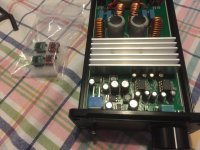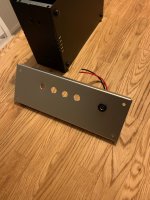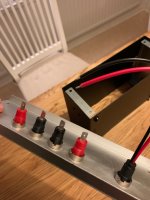Amazon/Fleabay ... take your pick and good luck on component quality, unless it is a known reliable supplier.
Anyone more who has used this tpa3255 board ?
Here is one DIY:er:
” am very impressed with the sound quality and I am amazed for the price it was. So far, and in in certain respects, it is far better than the £2.5K Linn AV 5125 it has replaced, especially in the Bass department which I find to be a bit wooly, undefined and lacking punch with the Linn (even though it's been recapped). Will get round to modifying the board by changing the usual suspects eventually and see what improvement we get.”

Here is one DIY:er:
There are plenty of cool pictures in the photo gallery threads posted in the other forums, so it only seems right that there be such a place to post your amp photos in the class d forum as well.
It doesn't matter whether you've got a prototype working on the breadboard, an amp jerry rigged on the table, or an electronic masterpiece in a case; post your stuff here for everyone to check out. It's a good way to share ideas and may even give someone a little bit of inspiration to tackle that project they've been wanting to do 🙂
It doesn't matter whether you've got a prototype working on the breadboard, an amp jerry rigged on the table, or an electronic masterpiece in a case; post your stuff here for everyone to check out. It's a good way to share ideas and may even give someone a little bit of inspiration to tackle that project they've been wanting to do 🙂
” am very impressed with the sound quality and I am amazed for the price it was. So far, and in in certain respects, it is far better than the £2.5K Linn AV 5125 it has replaced, especially in the Bass department which I find to be a bit wooly, undefined and lacking punch with the Linn (even though it's been recapped). Will get round to modifying the board by changing the usual suspects eventually and see what improvement we get.”
Last edited:
The bulk capacitors are weird. Some are 63V volt and single, some are 35V and connected in series(!). Better get one from AliX, those cheaper ones for €$35ish with active cooling fan are rather good.
Yes, some of those capacitors are coupled in series , probably because of cost ?
At the same time, one member said that it sounds better than a Linn 5125 and thats a big accievement If thats true. In gonna do a DIY build with this card and compare it to my Hypex ncore ( that I have compared to 5125 ) - they sounded the same , and much better than any average class A/B amplifier to my ears.

At the same time, one member said that it sounds better than a Linn 5125 and thats a big accievement If thats true. In gonna do a DIY build with this card and compare it to my Hypex ncore ( that I have compared to 5125 ) - they sounded the same , and much better than any average class A/B amplifier to my ears.
It is an absolutely low sophisticated chinese TPA3255 implementation. I have this board but it was put into the drawer as I settled with other boards.
IIRC, I paid not more than €32 for it.
Now I'm running the ZK-3002 boards (mono).
They have a proper designed cooling fan, a digitally controlled volume IC (don't remember what type), a proper decoupling and bulk capacitor arrangement.
IIRC, I paid not more than €32 for it.
Now I'm running the ZK-3002 boards (mono).
They have a proper designed cooling fan, a digitally controlled volume IC (don't remember what type), a proper decoupling and bulk capacitor arrangement.
Where did you find that information?a digitally controlled volume IC
The ZK-3002 board does not have a volume pot on it.
Hmm…. It looks like good value but I guess one has to swap the input 5532 IC and instead use opa1612 ?
I have those on adaptors and will report how it sounds .
No PFFB on this ofcourse.
Tantalums at the output ( in parallell ) ?
Good filter coils ?
First try will be with 36V 6A

I have those on adaptors and will report how it sounds .
No PFFB on this ofcourse.
Tantalums at the output ( in parallell ) ?
Good filter coils ?
First try will be with 36V 6A
Last edited:
Where did you find that information?
The ZK-3002 board does not have a volume pot on it.
There is only a 3-pin input connector on the board (for connection to the potentiometer).a digitally controlled volume IC
Digital adjustment 26dB-36dB does not refer to the digital volume, but to the amplifier gain adjustment.
The blue pot controls a 2ch digital pot of a type I don't remember (something chinese).
No need to argue against that, I'm 100% sure.
The connector you've marked in green is the L/GND/R audio input. If I remember correctly the topology is like that: 2ch opamp L/R input buffer -> 2ch digital pot IC -> 2x 2ch opamp create the balanced signal => TPA3255 inputs.

No need to argue against that, I'm 100% sure.
The connector you've marked in green is the L/GND/R audio input. If I remember correctly the topology is like that: 2ch opamp L/R input buffer -> 2ch digital pot IC -> 2x 2ch opamp create the balanced signal => TPA3255 inputs.
Last edited:
I will try it, will have it on friday and will do comparisons with Hypex ncore and Aiyima a04 tpa 3251.
If its less than good you will hear it
If its less than good you will hear it
- Home
- Amplifiers
- Class D
- Is this a good sounding TPA3255 board?


